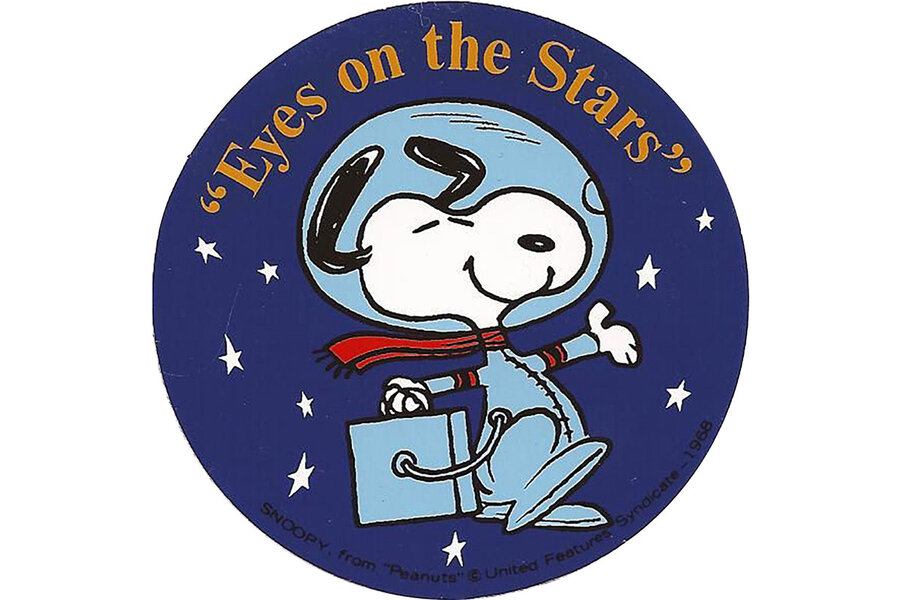Snoopy spurs kids to shoot for the moon
Step aside, Buzz Lightyear. America’s favorite flop-eared beagle has earned an official spot aboard NASA’s rockets.
Snoopy, who once shot for the stars as a mascot with the Apollo lunar missions in the 1960s, has returned to partner with the space organization. But this time his mission will be Earth-focused – he’ll be promoting space exploration and STEM education among kids.
NASA administrators hope that Snoopy will inspire students to take an interest in science, technology, engineering, and math at an early age so they have the necessary foundation to pursue STEM careers later in life if they choose to. Research has shown that only 26 percent of students who express interest in pursuing STEM majors in college are prepared to take the rigorous classes required.
Why We Wrote This
At NASA, they're not just looking up to the stars, they're looking to the future for rising talent. And now to help them, they've recruited Snoopy.
“[Some] kids are thinking, ‘I’m never going to be an author, I’m never going to be something that requires tons and tons of reading, but I’m really good with my hands and mechanical stuff.’ I really feel strongly that needs to be represented in schools,” says Bonnie Schulman, a fifth-grade teacher at Barnstable United Elementary School in Barnstable, Mass. “I’m sad still that schools seem to be catering toward one type of learner…. The kids who have other kinds of abilities, that might be science-related, they don’t necessarily feel successful in school.”
Brought to life by the pen of Peanuts’ creator Charles Schulz, Snoopy first excited Americans' cosmic wanderlust in the 1960s when he soared to the moon with nothing but a fishbowl on his head – beating the Russians and even the cat next door.
So when NASA’s Apollo 10 lunar module had to “snoop around” the moon’s surface in 1969 to determine Apollo 11’s landing site, the crew aptly nicknamed their craft Snoopy and the command module Charlie Brown. It’s an affiliation that stuck. To this day, NASA awards employees and contractors with the Silver Snoopy Award for “outstanding achievements related to human flight safety or mission success.”
Now NASA is taking its canine loyalty to new heights through a Space Act Agreement that will update Snoopy’s look “for space-themed programming with content about NASA’s deep space exploration missions,” according to a NASA-issued press release.
Refueling Americans' passion for space
When self-described NASA fan Patricia Rapp, who grew up during the lunar mission era, first heard about the renewed partnership between NASA and Snoopy, she immediately recalled the excitement she felt as a little girl watching Apollo 11 land on the moon.
“In 1969 I was 7, and I remember our family staying up late that night and we were all sitting on the couch,” says Ms. Rapp, who works at a library in Rochester, N.Y. “And we watched the lunar landing together…. [I]t was incredibly exciting to see the first steps on the moon.”
But even though she witnessed groundbreaking scientific history firsthand, Rap says it was Snoopy who made space seem fun. She remembers playing with a Snoopy astronaut action figure in the backyard, transforming it into the surface of the moon.
Peanuts and NASA will work together to create a STEM-themed curriculum for students, focused on US plans for space exploration. More details about the partnership will be released at San Diego’s Comic Con, which begins Thursday. This isn’t the first time NASA has partnered with a popular children's brand. LEGO and American Girl Doll have both launched products to promote STEM and space education among children in efforts to create new generations of space scientists and explorers.
“[NASA is] looking down the road to ensure that a pipeline of talented people with scientific and engineering backgrounds can come work for the agency, or its contractors, in the years to come,” says Jeff Foust, a senior staff writer for Space News. “There’s been a long-running concern in the industry that not enough people are pursuing careers in those fields.”
Mr. Foust says he wasn’t surprised to hear that NASA would be renewing its partnership with Snoopy, possibly because the space organization and its programs could use a boost from the sassy beagle’s charm.
While 72 percent of American adults think that the United States should remain a world leader in space exploration, only 18 percent think sending astronauts to Mars should be a top priority for NASA. Only 13 percent think it should be a top priority to send astronauts back to the moon, according to data published by Pew Research Center in June. Most Americans prefer NASA to monitor the Earth’s climate systems, or asteroids that could hit Earth.
A character like Snoopy, Foust says, could appeal to the nostalgia among Americans for a time of innovation and curiosity inspired by the lunar space missions, and at the same time renew public support for space exploration.
“Bringing back this partnership with Snoopy is incredibly nostalgic for people my age, but also for the young kids because Snoopy is such an icon,” says Rapp. “He’s been a part of our culture for decades. So anything that we can do to spark that excitement again about science … there's so much value in [that].”






